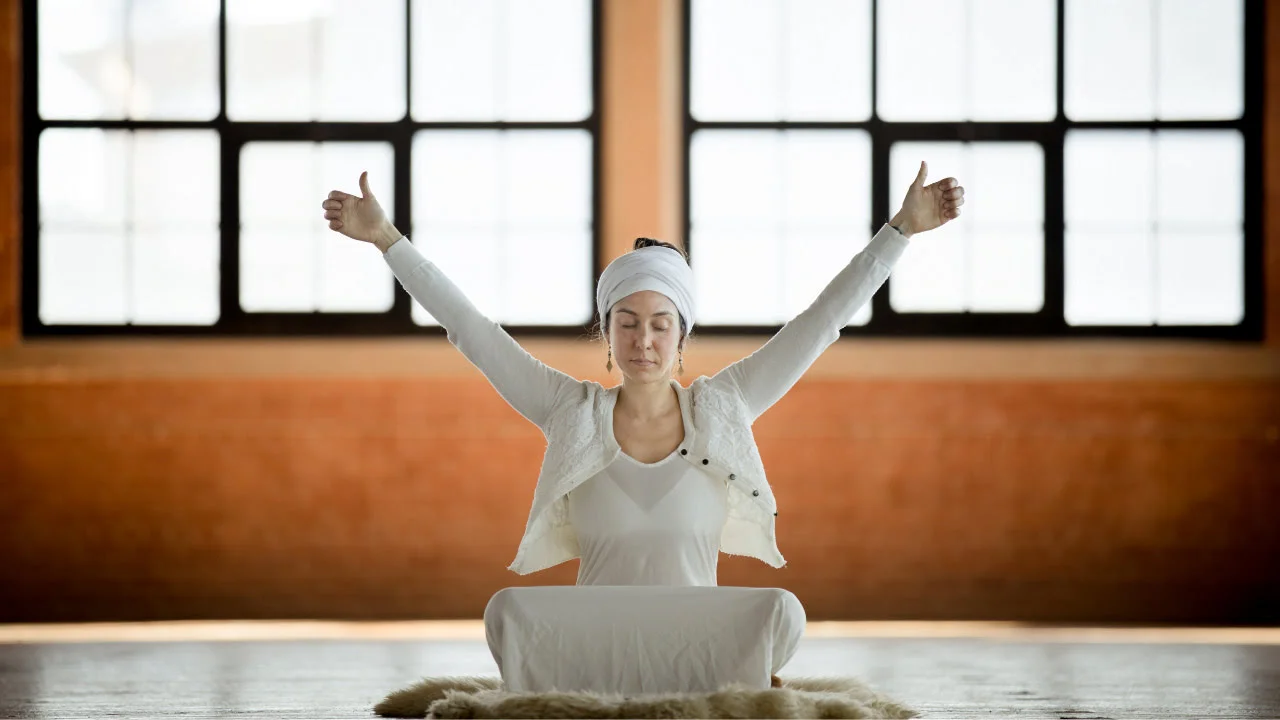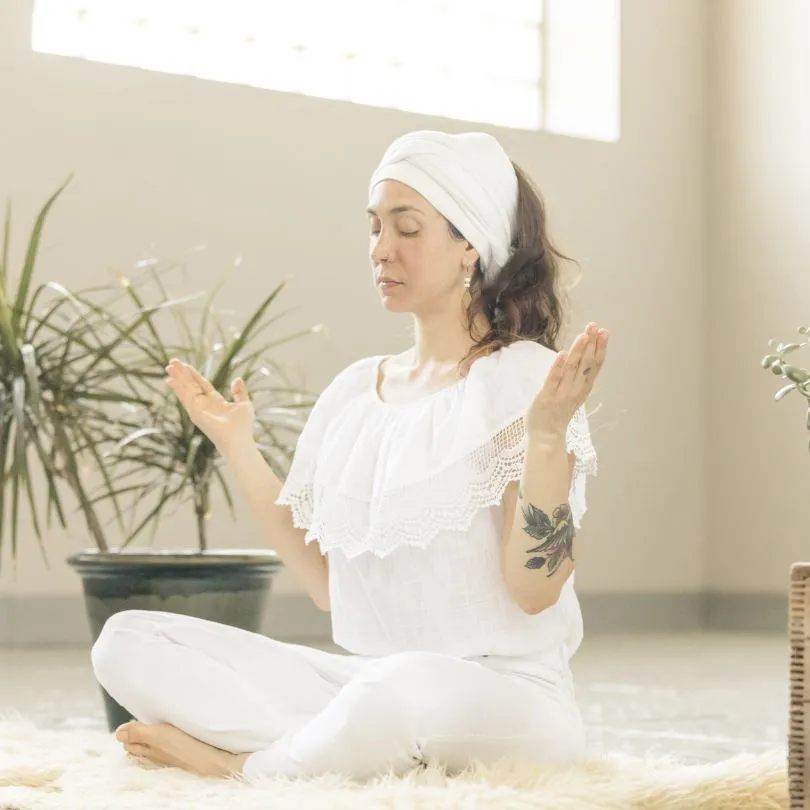The Ultimate Beginner Guide to Kundalini Yoga!

Imagine awakening a powerful, serpent-like energy coiled at the base of your spine. As it unfurls and rises through your body, it brings profound awareness, transcending the limits of the ego.
This transformative experience lies at the heart of Kundalini Yoga, an ancient practice that combines dynamic breathing, mantras, mudras (hand positions), and physical postures.
More than just a physical discipline, Kundalini Yoga is a journey of self-discovery and consciousness expansion. Its purpose? To awaken the dormant Kundalini Shakti, the sublime feminine energy believed to lay dormant within each of us.
Through a series of kriyas (exercise sets) designed to release blocked pranas (energies), practitioners seek to unleash this serpentine force, igniting a state of heightened intuition and self-realization.
Yet Kundalini is no mere esoteric concept – it is a tangible, physiological process that early yogis mapped to the human nervous system.
As the Kundalini awakens and rises through the chakras (energy centers), it is said to open pathways to higher consciousness and spiritual enlightenment.
This powerful practice, often called “the yoga of awareness,” offers a gateway to realms beyond the physical, beckoning those seeking profound personal transformation.
What is Kundalini Yoga?
The enigmatic origins of Kundalini Yoga have been cloaked in mystery for millennia. Yet its profound teachings have reverberated through ancient Vedic texts dating back over 3,000 years.
At its heart lies the concept of Kundalini – the “coiled serpent” of primordial energy lying dormant at the base of the spine, awaiting its awakening.
While now practiced globally, Kundalini Yoga is forever linked to Yogi Bhajan, the visionary master who first brought these sacred teachings to the West in the 1960s.
It was under his guidance that this potent practice emerged from obscurity, captivating spiritual seekers with its promise of arousing the slumbering serpent within.
The key aspects of Kundalini Yoga can be summarized as follows:
For the dedicated adherent, Kundalini Yoga promises to be a profound journey of self-discovery and union with the Divine within.

How does Kundalini Yoga differ from other yoga styles?
While all yoga traditions share roots in ancient philosophies and practices, Kundalini Yoga stands apart, carving its sacred path. Unlike styles that emphasize physical postures, like Hatha or Vinyasa, the primary focus of Kundalini isn’t mastery of the asanas. Instead, it is a portal into the mystical, a journey into realms beyond the physical.
Precision and repetition are the hallmarks of this practice. Rather than flowing fluidly with the breath as one might in a Vinyasa class, Kundalini Yoga combines chanting, singing, breath work, mudras (hand positions), body movements, and held postures into meticulously arranged sequences called kriyas.
These purposefully designed kriyas are repeated, building in intensity to catalyze the awakening of the Kundalini energy.
The aspirations of Kundalini also veer from the purely physical goals of other yoga styles. While practices like Hatha aim to cultivate strength, flexibility, and balance in the body, Kundalini’s objectives are more transcendent.
Each kriya is an invitation to shed the layers of the ego, activate the chakras, and unleash the coiled serpent power that dwells within.
For the Kundalini practitioner, the mat is a sanctuary where one doesn’t just exercise the body but embarks on a spiritual pilgrimage.
The songs, mantras, and movements are sacred technologies, precisely encoded to induce profound states of awareness and awakening. It is a blazing path of self-discovery, an odyssey into the vast mysteries of consciousness itself.
About Breathing, Mantras, Kriyas, and Mudras
Kundalini Yoga is a multifaceted practice that weaves together various sacred elements into a powerful technology for awakening. Every class follows a specific sequence, guiding practitioners through six main components:
Through the precise interweaving of these elements, Kundalini Yoga establishes a powerful field to catalyze the awakening of the Kundalini energy. Each component is purposefully wielded, making this practice as much a spiritual ritual as a physical discipline.

What are the benefits?
While the ultimate promise of Kundalini Yoga is spiritual awakening and enlightenment, this powerful practice offers a multitude of scientifically-backed and anecdotal benefits that extend into the physical, mental, and emotional realms. Let’s explore some of the most compelling:
Stress and Anxiety Relief
Like other yoga traditions, Kundalini is an effective antidote to the modern scourge of stress and anxiety. A 2017 study found that participants experienced immediate relief from stress after a Kundalini session, an effect that continued after 3 months of regular practice.
Similarly, research in 2018 concluded that 8 weeks of Kundalini Yoga significantly lowered anxiety levels, suggesting it could be a viable treatment option for generalized anxiety disorder.
Cognitive Enhancement
In a controlled 2017 trial on individuals with mild cognitive impairment, those who practiced Kundalini Yoga for 12 weeks displayed marked improvements not just in memory, but in vital executive functions like reasoning, problem-solving, and cognitive flexibility.
Remarkably, this group also reported fewer symptoms of depression compared to the control group.
Improved Body Image and Self-Perception
A small study highlighted Kundalini’s potential to foster greater self-acceptance and body positivity, benefits observed in women diagnosed with anorexia and bulimia nervosa. Researchers posited that by enhancing self-perception and self-appreciation, this practice could aid in treating eating disorders.
Spiritual Growth and Awakening
While challenging to quantify scientifically, the heart of Kundalini lies in its promised pathway to spiritual enlightenment. As the serpentine force awakens, practitioners report a host of profound shifts, including:
For those committed to the journey, Kundalini Yoga offers an initiation into the sublime mysteries of the self and the cosmos. As blocks are released and awareness expands, a new state of being beckons.
Kundalini Poses for Beginners
Eager to awaken the coiled serpent within? For the intrepid newcomer to Kundalini Yoga, certain poses offer an ideal initiation into this mystical practice.
But be warned – these are no ordinary asanas. Each one is a precise instrument, designed to stir the primal forces that slumber in your depths.

The Lotus Pose
Let us begin with the Lotus, that ancient seated pose revered for unlocking the hip chakras. As you Cross your legs, one foot ascending each thigh, you enter a sanctum of stillness.
Yet within that seeming repose, you kindle a sacred fire that adjudicates in its way that the real you will not be encapsulated by this carnal form.

The Cobra Pose
Here is the shape that myths are born from – the undulating snake inhaling breath itself as it rises from the earth.
By pressing your palms into the ground and lifting your heart skyward, you become that serpent, that kundalini propelling its way up your spinal channel. Feel its potent defenselessness as your belly blooms toward the sun.

The Archer Pose
And what of the Archer? This warrior stance encodes the skill of the ancient nomad – one foot rooted, the other ready to journey.
As you extend the archer’s arm, imagine pulling back the bowstring of your intention. With your opposite fist aimed at the heart, you awaken the relentless volition required to pierce the veils of illusion.
Is Kundalini Yoga Safe?
Like any physical practice, it’s crucial to approach Kundalini Yoga with prudence and awareness of your body’s needs and limitations. While this profound discipline can catalyze profound transformation, ignoring the following cautions could potentially lead to injury or aggravation of existing conditions:
If you have any of these conditions, it’s advisable to consult your doctor before starting a Kundalini practice. They can guide you on necessary precautions or potentially recommend a gentler exercise option better suited to your needs.
Final Takeaway
Kundalini Yoga stands apart as a spiritual odyssey, using chanting, singing, breath work, mudras, and purposefully choreographed movements to awaken the transformative life force slumbering within.
Research points to several potential benefits, including reduced stress/anxiety, improved cognition, and greater self-acceptance.
However, its dynamic nature also necessitates mindful consideration of one’s physical condition before embarking on the path. With proper guidance and precautions, Kundalini can be a powerfully uplifting practice.
But ignoring limitations could dim the radiant light it seeks to ignite. As with all journeys of the soul, the path is unique to each traveler.
Namaste 🙂
Also See: Hatha Yoga, Ashtanga, Restorative Yoga, Vinyasa, and Iyengar Yoga!

